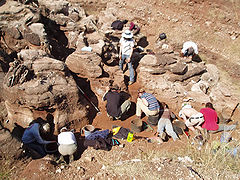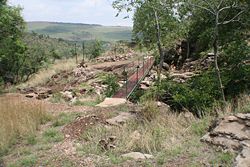
Gladysvale Cave South Africa
Encyclopedia

Sterkfontein
-References:-References:-References:: : : :...
and Swartkrans
Swartkrans
Swartkrans is a location in South Africa, around from Johannesburg.Swartkrans is a farm near to Sterkfontein, notable for being extremely rich in archaeological material, particularly hominid remains. It was purchased by the University of the Witwatersrand in 1968...
and about 45 km North-Northwest of the City of Johannesburg
Johannesburg
Johannesburg also known as Jozi, Jo'burg or Egoli, is the largest city in South Africa, by population. Johannesburg is the provincial capital of Gauteng, the wealthiest province in South Africa, having the largest economy of any metropolitan region in Sub-Saharan Africa...
, South Africa
South Africa
The Republic of South Africa is a country in southern Africa. Located at the southern tip of Africa, it is divided into nine provinces, with of coastline on the Atlantic and Indian oceans...
. It is situated within the Cradle of Humankind
Cradle of Humankind
The Cradle of Humankind is a World Heritage Site first named by UNESCO in 1999, about 50 kilometres northwest of Johannesburg, South Africa in the Gauteng province. This site currently occupies ; it contains a complex of limestone caves, including the Sterkfontein Caves, where the 2.3-million...
World Heritage Site
World Heritage Site
A UNESCO World Heritage Site is a place that is listed by the UNESCO as of special cultural or physical significance...
.
History of Investigations
Gladysvale is the first cave that Robert BroomRobert Broom
Professor Robert Broom was a Scottish South African doctor and paleontologist. He qualified as a medical practitioner in 1895 and received his DSc in 1905 from the University of Glasgow...
visited in the Transvaal in his mid-1930s search for a hominid-bearing cave nearer to Johannesburg than Taung. He visited Gladysvale after a butterfly collector from the Transvaal Museum reported a "human mandible" in the wall of the cave. When Broom arrived at the cave the mandible was gone. Sterkfontein soon lured Broom away from the site. In 1946 Phillip Tobias
Phillip V. Tobias
Phillip Vallentine Tobias is a South African palaeoanthropologist and Professor Emeritus at the University of the Witwatersrand in Johannesburg...
led a student expedition to the site where a fine baboon
Baboon
Baboons are African and Arabian Old World monkeys belonging to the genus Papio, part of the subfamily Cercopithecinae. There are five species, which are some of the largest non-hominoid members of the primate order; only the mandrill and the drill are larger...
fossil was recovered. In 1948 Frank Peabody of the Camp-Peabody expedition from the United States spent several weeks at Gladysvale but failed to find any hominid remains. The site was lost from scientific memory until it was re-opened by Lee Berger
Lee R. Berger
Lee Rogers Berger is a paleoanthropologist, physical anthropologist and archeologist and is best known for his discovery of Australopithecus sediba and his work on Australopithecus africanus body proportions and the Taung Bird of Prey Hypothesis.-Background:Berger was born in Shawnee Mission,...
and Andre Keyser
Andre Keyser
Andre Werner Keyser , was a South African palaeontologist and geologist noted for his discovery of the Drimolen hominid site and of numerous hominid remains....
in 1991. Within a few weeks of excavation the first hominid remains were discovered - two teeth of Australopithecus africanus
Australopithecus africanus
Australopithecus africanus was an early hominid, an australopithecine, who lived between 2–3 million years ago in the Pliocene. In common with the older Australopithecus afarensis, A. africanus was slenderly built, or gracile, and was thought to have been a direct ancestor of modern humans. Fossil...
. This discovery made Gladysvale the first new early hominid site to be discovered in South Africa since 1948 (when the last site - Swartkrans - was discovered by Robert Broom
Robert Broom
Professor Robert Broom was a Scottish South African doctor and paleontologist. He qualified as a medical practitioner in 1895 and received his DSc in 1905 from the University of Glasgow...
).
Since the discovery of these teeth more than a quarter of a million fossils have been recovered from Gladysvale during excavations conducted by joint teams from the University of the Witwatersrand
University of the Witwatersrand
The University of the Witwatersrand, Johannesburg is a South African university situated in the northern areas of central Johannesburg. It is more commonly known as Wits University...
, the University of Zurich and Duke University
Duke University
Duke University is a private research university located in Durham, North Carolina, United States. Founded by Methodists and Quakers in the present day town of Trinity in 1838, the school moved to Durham in 1892. In 1924, tobacco industrialist James B...
.
Recovered Fossils
Many thousands of fossils have been recovered from the Gladysvale deposits including rare remains of hominids. From the Gladysvale external deposits, almost a quarter of a million bones have been recovered since excavations began in 1992. There are many millions of bones still in place in the cave. Fossils recovered include antelopeAntelope
Antelope is a term referring to many even-toed ungulate species indigenous to various regions in Africa and Eurasia. Antelopes comprise a miscellaneous group within the family Bovidae, encompassing those old-world species that are neither cattle, sheep, buffalo, bison, nor goats...
, giant zebra
Zebra
Zebras are several species of African equids united by their distinctive black and white stripes. Their stripes come in different patterns unique to each individual. They are generally social animals that live in small harems to large herds...
, carnivores including extinct wolves, monkeys and hominids attributed to Australopithecus africanus and early Homo
Homo (genus)
Homo is the genus that includes modern humans and species closely related to them. The genus is estimated to be about 2.3 to 2.4 million years old, evolving from australopithecine ancestors with the appearance of Homo habilis....
.
Tools have also been found with the most spectacular being an Acheulean handaxe (pictured), recovered from 1 million year old sediments.
Geology
Gladysvale has become well known for its exceptional horizontally-bedded stratigraphyStratigraphy
Stratigraphy, a branch of geology, studies rock layers and layering . It is primarily used in the study of sedimentary and layered volcanic rocks....
and has been the site of the testing of many of the absolute dating techniques which have proved


Age of the Deposits
The Gladysvale sequence has been dated using a combination of biostratigraphy, palaeomagnetism (Andy Herries, La Trobe University, Australia), electron spin resonance (Darren Curnoe, UNSW, Australia) and uranium series dating (Robyn Pickering, U. Melbourne, Australia). The youngest deposits are thought to be around 54,000 years old while the oldest deposits that are the likley source of the Au. africanus fossils are around 2.4-2.0 million years old. The Gladysvale External deposits contain extensive faunal remains and date to between 780,000 and 530,000 years ago. An Acheulian handaxe was recovered from internal deposits older than the Bruhnes-Matuyama boundary at 780,000 years.
Other Related Links

- Hominids
- Australopithecus africanusAustralopithecus africanusAustralopithecus africanus was an early hominid, an australopithecine, who lived between 2–3 million years ago in the Pliocene. In common with the older Australopithecus afarensis, A. africanus was slenderly built, or gracile, and was thought to have been a direct ancestor of modern humans. Fossil...
- Cradle of HumankindCradle of HumankindThe Cradle of Humankind is a World Heritage Site first named by UNESCO in 1999, about 50 kilometres northwest of Johannesburg, South Africa in the Gauteng province. This site currently occupies ; it contains a complex of limestone caves, including the Sterkfontein Caves, where the 2.3-million...
- List of fossil sites
- Lee BergerLee R. BergerLee Rogers Berger is a paleoanthropologist, physical anthropologist and archeologist and is best known for his discovery of Australopithecus sediba and his work on Australopithecus africanus body proportions and the Taung Bird of Prey Hypothesis.-Background:Berger was born in Shawnee Mission,...

